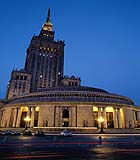|
|
Facts About Poland
Introduction:
Welcome to Poland, a country which provides unforgettable
experiences for tourists with even the most diverse interests. The
enthusiasts of nature will surely enjoy the golden sand of its
Baltic coastal beaches to the north and the rocky crags of the
Tatras to the south. There is the wonderful network of great
Mazurian Lakes for water sports fans and the green wilds of the
Bieszczady Mountains for those who like hiking trips.
To
those with a taste for history and its mementoes, Poland extends an
invitation to visit the many painstakingly restored old town
complexes, the Royal castles of Warsaw and Krakow, the former
capital, and into t he old palaces erected by Poland's magnates.
Numerous museums are brin ging to mind the memory of bygone
centuries such as the Nicolaus Copernicus Biographical Museum in the
former seat of Warmian bishops in Frombork or the medieval
underground salt mine in Wieliczka.
|
 |
|
In
Poland there is a heart-warming proverb all Poles take very
seriously. It translates roughly into -a guest in the house is God
in the house. That is why, regardless of where or how they live,
Poles draw on their long tradition of -Slavic Hospitality- to
welcome people from home and abroad with warmth and affection.
Poland is a place where family values are cherished highly and
friendships last a lifetime. In spite of a turbulent history and the
dramatic changes shaping Polish society today, Poles have vigorously
maintained a distinct sense of culture and community. Come and meet
them on their home ground and visit the land that continues to
motivate and inspire them.
Climate:
Poland has a temperate climate. During
the summer, the average temperature in July is 76 degrees
Fahrenheit. There are, of course, hot days when the temperature
exceeds 86 degrees. The coldest winter months are January and
February. The average January temperature drops to a few degrees
below zero. With huge snowfalls, the Polish mountains offer good
conditions for winter sports enthusiasts. Click here for the latest
weather forcast for Warsaw.
Population:
With 38.6 million inhabitants, Poland
is divided into 16 administrative provinces called wojewodztwa.
The capital city of Warsaw (Warszawa)
is located on the Vistula (Wisla) River and has a population of
1,625,000 people.
Today, citizens of Poland are largely
of Polish nationality and more than 90% declare themselves as Roman
Catholics. |
|
Language:
LANGUAGE:
Spoken by 99 percent of the population, the official language is
Polish. English, German and Russian are among the better known
foreign languages in Poland, especially in the larger urban
centers. There are increasing numbers of speakers of both,
although extensive foreign language studies became widespread
only a few years ago. Thus, the foreign traveler may still
experience some language difficulties in small towns or remote
areas. |
 |
|
|
Geography:
The
Republic of Poland is located in Central Europe. It borders Germany
to the west, the Czech Republic and Slovakia to the south, and
Russia, Lithuania, Belorus and the Ukraine to the east. The Baltic
Sea defines its northern border. Warsaw is sited upon the Vistula -
Poland's largest river. It flows northwards, from the mountains
towards the Baltic Sea, thus cutting the country into two parts. The
second largest river is the Odra, which forms the border between
Poland and Germany.
Poland is a country with varied topography. The Sudeten and
Carpathian Mountains stretch along Poland's southern borders. The
Sudeten belong to the oldest mountainous massifs in Europe. Their
highest peak is Mount Sniezka - 1,602 meters above sea level. The
Carpathians are younger. The Tatra Range makes up their central part
- it is the only portion of Polish mountains of the alpine
character. It contains Poland's highest peak - Mount Rysy at 2,499
meters above sea level. Hundreds of lakes are hidden away in the
northern part of the country, in the Pomeranian and Mazurian
Lakelands where countless lakes are found amidst picturesque hills
and beautiful forests. The largest one is Lake Sniardwy, which
occupies a surface area of 109,700 hectares. Further north are the
sandy beaches of the Baltic Sea. Poland's major ports on the Baltic
coast are Gdansk, Gdynia and Szczecin.
Forests with very rich undergrowth cover 27 percent of the whole
country area. The most common species is the pine tree. The largest
forest complexes include the Bory Dolnoslaskie, Bory Tucholskie,
Puszcza Augustowska, Puszcza Knyszynska, Puszcza Bialowieska, and
Puszcza Solska. Many rare plant and animal species are under
protection. |
|
|